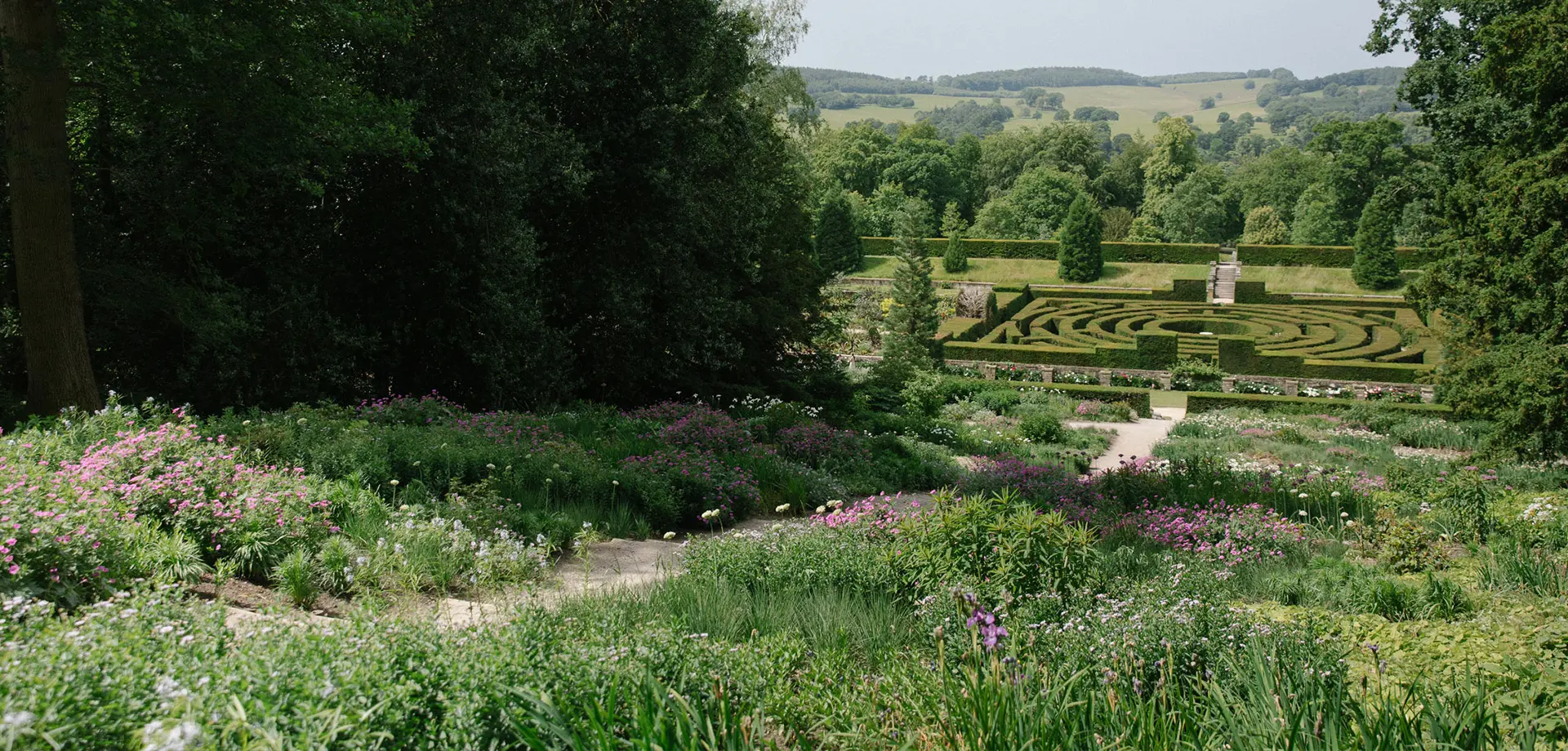The 12th Duke and Duchess, working with the Chatsworth Garden team and celebrated garden designers Tom Stuart Smith, Dan Pearson and James Hitchmough, oversaw the biggest transformation of the garden for 200 years. The 25-acre project included a remodelled Rockery, the Maze borders, the Ravine, and Dan Pearson’s redevelopment of the Trout Stream and the Jack Pond.
Central to the redesign was Arcadia; a 15 acre area at the heart of the garden that lay undeveloped until work began in 2018. Created in-house by the Chatsworth Garden team, to a plan by Tom Stuart Smith, Arcadia is made up of peaceful meadow-like glades connected by woodland walks and featuring site-specific sculpture installation.
Arcadia’s elevated situation provides views out across the park, and its configuration creates new routes between other parts of the garden that surround it. These include the Rockery and Maze to the west, the Trout Stream to the east, and the Grotto Pond to the south while the Cascade is situated to the north.
The area is made up of four glades, each with its own characteristics.
In the rabbit glade, Davidias, Viburnum and Hydrangea frame the sloping site with views onto the maze garden, while Geraniums, Heuchera, Euphorbia and Galium, amongst many other genus and species, cover the planting beds. Drifts of Primula, violets and bulbs emerge first in spring with grasses and seed heads hanging on into autumn and winter.
The wet glade makes use of moisture that is already in the area from nearby streams and harnesses pre-existing features such as the Emperor main that runs underneath the glade for irrigation. Swamp Cypress, Rhododendrons and Magnolia give structure with thousands of Primulas in Spring giving way to Rodgersia, Gunnera, ferns and Darmera for foliage, and many varieties of Iris, Persicaria and Aster for colour.
The meadow glade area was sown with a cultivated perennial meadow developed by Professor James Hitchmough from the Landscape Architecture Department, at Sheffield University. James’s scientifically designed seed mix contains over 70 different species of plant that will flower between March and the end of July each year.
The 100 Steps Glade runs up the hillside from The Maze, and lead to the monumental, contemporary sculpture at the top, Chaos Meteoro by Jedd Novatt. The stone flue which snakes either side of the steps is a remnant of the heating system from Joseph Paxton’s Great Conservatory. The planting was designed by Tom Stuart Smith to enhance the views over the formal garden out across to the wider landscape, and features perennials and grasses including Aster, Geranium, Iris, Phlox, Molinia and Pennisetum as well as Rhododendron, Kalmia, Hydrangea and Euonymus.
Sustainability was a big factor in the design and execution of the entire Arcadia project. 95% of the planting was peat free and was either grown in the open ground and transported bare root, or was in biodegradable pots that was made from remoulded husks which is by-product of the rice industry.
In addition to the myriad of plants, a new sculpture titled ‘Natural Course’ has been built within Arcadia. Designed to appear as if seeping from the ground and flowing down a woodland slope, the monumental piece has been created from more than 100 tonnes of local stone and sits in woodland between two of the glades. The area is punctuated with newly planted Davidia or ‘Ghost Tree’ as well as flowering perennials including Epimedium, Hellebore and Iris, allowing the sculpture to sit with ease within the surrounding landscape.
Discover more from the modern garden
Ravine and Azalea Dell
In the early 1930s, the 9th Duke’s wife, Evelyn, in collaboration with the head gardener, J. G. Weston, created the Ravine and the Azalea Dell in the south of the garden.
Rose Garden
Originally the French Garden, in 1939 Duchess Mary, wife of the 10th Duke, remodelled this area and it became known as the Rose Garden.
Serpentine Hedges
The Serpentine Hedges were created from an idea of Duchess Deborah's.
Display Greenhouse
This greenhouse is sited to the north of the First Duke's Greenhouse and has three climate zones: tropical, Mediterranean and temperate.
The Maze
Originally the site for Paxton's Great Conservatory, this garden is now home to a large yew maze.
Kitchen Garden
Chatsworth has grown its own food for centuries and all manner of fruit, salad, cut flowers and vegetables are grown in the kitchen gardens.
Snake Terrace
In 1974, the Snake Terrace was constructed in the space between the First Duke's Greenhouse and the Display House.
Sensory Garden
The Sensory Garden was an idea instigated by Lord Burlington, the 12th Duke's son.
Quebec
In 2008, the 12th Duke and Duchess re-established Quebec, a long-over-grown area below the Canal Pond.
Summer House and Golden Grove
Near the Summer House is a plot planted in gold and yellow – the Golden Grove. All the shrubs and small trees here were given by friends and neighbours of the 11th Duke and Duchess to mark their golden wedding in 1991.
Cottage Garden
The Cottage Garden was created in 1989 with topiary 'rooms' and 'furniture' created out of box, privet and yew hedges.
Learn about the early garden
The house and garden were first constructed by Sir William Cavendish and Bess of Hardwick in 1555. The Elizabethan garden was much smaller than the modern garden is now.
Discover the 6th Duke's Garden
The 6th Duke, working with renowned gardener Joseph Paxton, made radical and pioneering changes to the Chatsworth Garden and Estate.



